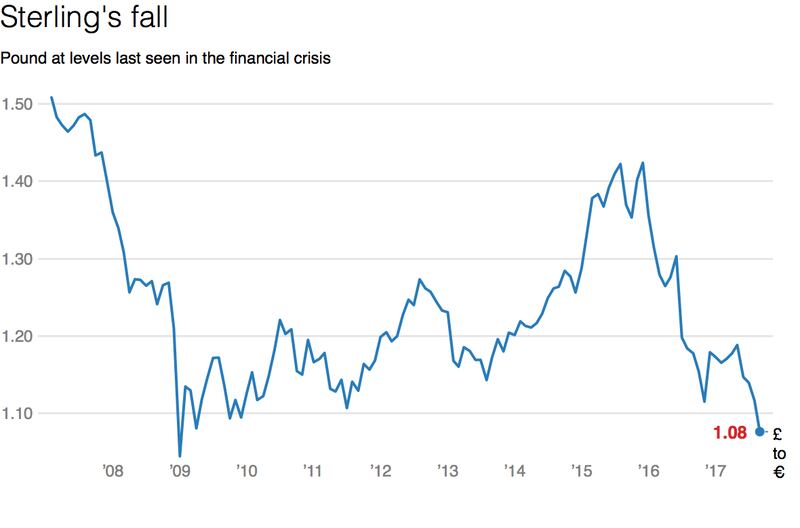The sterling exchange rate is well into danger territory for Irish exporters: yesterday the pound was slumping below 93p against the euro for the first time since 2009. Those particularly exposed are the small and medium-sized companies whose main or only export market is the United Kingdom; sterling's weakness will make their products more expensive for UK customers.
Many of the Irish companies are in food and engineering, and based in rural areas; the Border region is particularly exposed. Retailers and tourism companies that rely on UK business will also be exposed if the pound continues to lose value against the euro.
Of course it is a big if. One of the first events I was sent to as a reporter involved a visiting expert from one of the world’s biggest investment banks giving a compelling case for why the dollar could only fall from the levels it was then at. It went in the completely opposite direction for the next two years, and by the time the decline did come our friend had left the bank “to purse other interests”.
At a time when you have Brexit on one side and big questions about the future of euro interest rates and European Central Bank policy on the other, we just don't know where the exchange rate will go. As we reported last week, many forecasters here are sceptical of talk from a couple of big investment banks that parity is on the cards. But, either way, we are now at levels that are hitting home.
A survey by Bord Bia earlier this year of its client companies – food and drink exporters – showed that 39 per cent of exporters to the UK found a rate of more than 89p to the euro would cause severe difficulties and that a rate of more than 94p would cause big problems for a further 41 per cent. So we are close to levels that are going to cause significant problems for eight out of 10 food exporters to the UK.
An analysis by Ibec, the employers' body, based on historic exchange-rate and trade data, came to similar conclusions. It suggested that Irish exporters start to feel the pain as the rate moves over 85p and that things start to look significantly worse once sterling falls to more than 90p against the euro.
When you consider that yesterday’s rate of more than 93p means that sterling has fallen more than 10p against the euro since April, you realise the scale of the change facing Irish exporters. Hedging and currency management can help, but the longer this persists the more difficult it becomes and the more problematic it is to get hedging and other protection at a reasonable price.
Sources say that many companies are, understandably, more exposed now than they were when sterling weakened a year ago, immediately after the Brexit vote, and again later in the year. And, yes, companies can, over time, diversify into new markets, but it is not easy, it takes a long time and, for some, it will be impossible.

The latest fall puts the focus back on the sterling factor, after months of debate about whether companies trading with the UK would face tariffs and customs barriers after it leaves the European Union. This remains a live question – and one unlikely to be solved until later in the Brexit talks, when the future share of the UK-EU trading relationship becomes clear.
But sterling is the clear and present danger both for exporters and for those competing with UK products on the Irish markets.
Tourism would also be hit by a prolonged weakness, with signs already of a fall-off in the number of UK visitors, down 6.5 per cent on last year. Meanwhile shoppers from the Republic will be lured north and, perhaps more significantly, will find it more attractive to buy online from UK retailers.
If the currency trend persists, pressure will build on the Government to react. Already Enterprise Ireland and Bord Bia are helping companies to diversify their markets, but this is by its nature a slow process. The Government is believed to be talking to Brussels about clearance under state-aid rules for further supports, such as a greater availability of grant-aid investment to support productivity.
Businesses are also calling on the Government to put an immediate focus on areas where it can control and influence costs to business – everything from rates to taxes to utilities. The National Competitiveness Council identifies the problems each year, but in many areas there is little by way of follow-up.
The Government will hope that the more sanguine forecasts of a sterling recovery prove correct. But it cannot rely on this – and, looking back, last year’s budget did little to help. The Government needs to have its plan for parity in place, even if it hopes never to have to use it in full.














